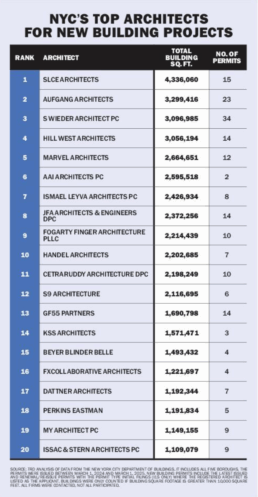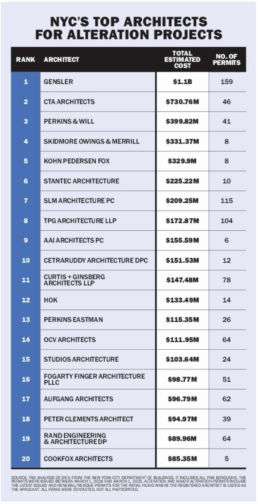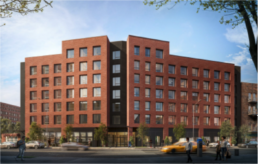Work Begins On Upscale Village With Apartments, Shops, Ice Rink In Tuxedo2

Work Begins On Upscale Village With Apartments, Shops, Ice Rink In Tuxedo
A massive new luxury town center is rising in the Hudson Valley, bringing high-end apartments, shops, and public amenities to Orange County.
By Ben Crnic
Construction has officially started on Market Square and The Village Town Center at Tuxedo Reserve, a 1,200-acre development located in the town of Tuxedo near the Sloatsburg border, designer Aufgang Architects announced on Tuesday, June 10.
The project, designed by Aufgang’s Aurae Luxury Division, will include 93 upscale rental apartments across four mixed-use buildings, with 38,000 square feet of ground-floor commercial space. The residential units will offer one- and two-bedroom layouts ranging from 700 to 1,400 square feet, many featuring dens and large mudroom entry areas.
The town center, envisioned as the Main Street of Tuxedo Reserve, will include shopping, dining, and year-round events. Community amenities will feature a high-end grocery store, café, seasonal ice rink that converts to a yoga and event space, food truck pavilion, fitness center with basketball court, dance, and yoga studios, a four-lane lap pool, hot tub, and children’s play area.
The project is being developed in partnership with The Related Companies. Construction is expected to be completed within 18 months.
“Tuxedo Reserve is one of the region’s most ambitious developments,” said Ariel Aufgang, AIA, Principal of Aufgang Architects. “Our Aurae luxury division created something truly special here—a charming downtown that captures the essence of Hudson Valley living.”
Tuxedo Reserve is located just off the Orange Turnpike and is about 90 minutes from New York City.
Link to Original Article:
Construction begins at Tuxedo Reserve project in Tuxedo

Construction begins at Tuxedo Reserve project in Tuxedo
By Peter Katz
Construction has begun on what will be the downtown area of Tuxedo Reserve, a new community in Tuxedo in Orange County. Lennar and Related Companies are the developers of the project.
Tuxedo approved an Amended Special Permit for the development consisting of 1,609 dwelling units in a variety of single-family homes, townhouses and apartment buildings. Part of the project is in the Village of Sloatsburg. The total land area of the site is about 2,247 acres, of which about 1,200 acres will be developed.
The Amended Special Permit provides that no less than 269 units shall be single-family detached units and no less than 112 units shall be duplex units. The Amended Special Permit requires a minimum of 35,000 square feet of commercial uses with a maximum of 100,000 square feet of combined commercial uses and amenities.
The developer is required to build an approximately 4,000-square-feet Event Building for community events. The developer also is require to construct a system of trails on the property, as well as preserving undeveloped sections of the property.
Portions of the project known as Market Square and The Village were designed as the town center. The Village will feature rental apartments. Amenities for the entire community include a high-end grocery and a café, a seasonal ice-skating rink that converts to public yoga and event space during warmer months, a pavilion for food trucks, surface parking and a state-of-the-art fitness center with a basketball court, dance and yoga studios. The complex also features a four-lane lap pool, with hot tub and children’s play area.
Ariel Aufgang, principal of Aufgang Architects, which designed Market Square and The Village, said that the downtown area they’ve designed for the project captures the essence of Hudson Valley living.
“We’re creating spaces where residents can live and work, in a walkable downtown setting, amidst the natural beauty that makes the Hudson Valley so special,” Aufgang said.
According to Greg Gushee, executive vice president for Related Companies, the design of the project was inspired by the small towns and hamlets found all across America.
Lennar will be offering single-family residences and townhouses.
“We’re excited to expand our presence into the New York market,” said Dana Romano, Lennar’s New York/New Jersey division manager. “It’s been an honor to collaborate with the Town of Tuxedo and Related Companies to create this master-planned community.”
Sales for single-family homes and townhouses are planned to begin this year. Leasing for rental units in The Village is expected to begin next year.
Link to Original Article:
Work Begins On Upscale Village With Apartments, Shops, Ice Rink In Tuxedo

Work Begins On Upscale Village With Apartments, Shops, Ice Rink In Tuxedo
A massive new luxury town center is rising in the Hudson Valley, bringing high-end apartments, shops, and public amenities to Orange County.
By Ben Crnic
Construction has officially started on Market Square and The Village Town Center at Tuxedo Reserve, a 1,200-acre development located in the town of Tuxedo near the Sloatsburg border, designer Aufgang Architects announced on Tuesday, June 10.
The project, designed by Aufgang’s Aurae Luxury Division, will include 93 upscale rental apartments across four mixed-use buildings, with 38,000 square feet of ground-floor commercial space. The residential units will offer one- and two-bedroom layouts ranging from 700 to 1,400 square feet, many featuring dens and large mudroom entry areas.
The town center, envisioned as the Main Street of Tuxedo Reserve, will include shopping, dining, and year-round events. Community amenities will feature a high-end grocery store, café, seasonal ice rink that converts to a yoga and event space, food truck pavilion, fitness center with basketball court, dance, and yoga studios, a four-lane lap pool, hot tub, and children’s play area.
The project is being developed in partnership with The Related Companies. Construction is expected to be completed within 18 months.
“Tuxedo Reserve is one of the region’s most ambitious developments,” said Ariel Aufgang, AIA, Principal of Aufgang Architects. “Our Aurae luxury division created something truly special here—a charming downtown that captures the essence of Hudson Valley living.”
Tuxedo Reserve is located just off the Orange Turnpike and is about 90 minutes from New York City.
Link to Original Article:
Leading Architects Think Smaller

Leading Architects Think Smaller
Tax breaks pave way for more projects with different scopes
By Jake Indursky | Research By Matthew Elo and Joseph JungerMann
FOR ARCHITECTS, 2024 WAS A TALE IN TWO parts. They spent the first half stuck in the mud as developers waited for housing policy clarity and the second half in a welcome return to form.
“In the second half, we started getting some movement — some market-rate housing, office conversions into housing and different things like that — as people started to learn about these new abatements and new affordability programs,” Aufgang principal Ariel Aufgang said.
Many of the top firms on The Real Deal’s rankings, which take into consideration the number of permits filed with the Department of Buildings, held onto previous spots. Gensler and SLCE retained their pole positions for alterations and new builds, respectively.
“We did better in 2024 than what we did during Covid and 2023,” said SLCE partner Saky Yakas, whose firm is working on projects like the Flatiron Building conversion and One Times Square.
Despite legislative life rafts, architects confirmed that the new state of play — high interest rates, cost uncertainty and tricky zoning — requires a keener eye. It may mean more business compared to years past, but the scope of architectural projects has changed as developers contort building plans for new tax breaks.

“You have to be a solid developer now for development,” said JFA chief operating officer and partner Ben Grunwald. “You have to know what you’re doing… if you know what you’re doing, at least, you could have a game plan.”
City of “at last”
City of Yes’s passage opened up a world of opportunity for architects. It also opened up a world of work. “Owners immediately wanted us to see what the implications were,” said Yakas, who has already added floors and units and upgraded drawings on three affordable housing projects across Brooklyn and Queens.
The plan’s Universal Affordability Preference, which replaces the city’s Voluntary Inclusionary Program, grants 20 percent density bonuses to projects if all of the extra space is dedicated to permanently affordable housing.
City of Yes also created more housing production opportunities, including loosening of parking minimums and the inclusion of denser R11 and R12 zoning.
CetraRuddy founding principal Nancy Ruddy said that the real driver of business for her firm this year has been office-to-residential conversions, spurred by City of Yes expanding the convertible building stock.
“That has been a major source of work and construction jobs, even clients who have never done renovations and conversions,” said Ruddy, whose firm is working on the nation’s largest conversion, 25 Water Street in the Financial District.
Perhaps more surprising is the surge of office-to-office conversions. Developers are increasingly looking to upgrade existing office buildings as demand for quality office space has surged, according to Kohn Pederson Fox principal Forth Bagley. Manhattan’s first-quarter vacancy rate was 17.7 percent, according to Savills.
The industry also finally got clarity on 485x last year. While the industry breathed a sigh of relief at receiving a fresh tax abatement, architects are now working with developers to adhere to deeper affordability and prevailing wage requirements.
“People are looking for smaller deals — clients that used to build 500-unit buildings are now looking at 100-unit buildings or less,” Grunwald said. Whether that’s good news for architects depends on whom you’re asking.
“It’s counterproductive, frankly,” said Hill West founding partner David West. He said that developers are looking to break sites into multiple smaller buildings when possible, or in the case of one planned 450 unit tower, pausing all together.
Even then, sites being broken up into several buildings requires multiple lobbies, multiple elevator cores, double the management staff and double the application and permit filings for architects, he said. “I think it’s an unintended consequence,” West said. “I don’t think the tax abatement rules should be driving the decision-making.”
Show me the money
Affordable housing projects have proven especially crucial — if they land financing.
“The biggest problem now is there are more projects than there’s funding,” said Curtis + Ginsberg partner Mark Ginsberg, who has a number of projects on hold until clients can get funding.
Architects have found success this year through the city’s efforts to rehabilitate New York City Housing Authority properties through its Permanent Affordability Commitment Together program, which allows land to be leased to developers who complete needed repairs
Aufgang is working with developers on three different projects in the Bronx and Brooklyn where units are being renovated “top to bottom,” he said.
Recently, though, the Trump administration has turned its eye on federal affordable housing funding, which could further threaten many projects’ cash streams.
Despite months of tariff whiplash and stubbornly high interest rates, architects looking ahead feel they have navigated the Covid trough and can visualize the next boom cycle.
“There’s this pent-up need of wanting to develop, we’re seeing a real parallel between what happened after Covid and what happened after the 2008 and 2009 recession,” Ruddy said. “A city like New York always comes back.” TRD

Supportive Housing and Transient Shelters
Supportive Housing and Transient Shelters
Emergency supportive housing and shelters can differ drastically in what is needed for their residents, depending on whether they are serving families or single adults. This portfolio displays a variety of shelters, both new construction and building conversions.
Affordable Housing
Affordable Housing
To accommodate the increasing demand for affordable housing for America’s workforce, Aufgang has been dedicated to creating many reliable and attractive options. This portfolio shows some of the newest projects that have shaped the city skyline.
Cultural, Commercial, and Community Facility
Cultural, Commercial, and Community Facility
In addition to residential and mixed-use projects, Aufgang also has designed commercial projects such as offices, schools, and retail. This portfolio includes both new construction and adaptive reuse of historical buildings.
Low Rise
Low Rise
Apartments of 4-6 stories are preferred over high-rises in the suburbs and in certain city neighborhoods. This portfolio showcases a variety of market-rate projects across New York State.
Market Rate Residential
Market Rate Residential
Some of Aufgang’s most elegant designs appear in the market rate collection, with many featuring desirable amenities, gorgeous rooftop views, and beautiful interiors. This portfolio shows some of the firm’s most unique designs.
Construction starts on Aufgang designed 85-unit Ogden Theater Apartments

Construction starts on Aufgang designed 85-unit Ogden Theater Apartments
Bronx, NY Construction has begun on an Aufgang Architects designed 100% affordable community that includes supportive housing, in the Highbridge section of the city.
The 85 unit Ogden Theater Apartments, located at 1415 Ogden Ave., will include 51 units of supportive housing for formerly homeless and 34 units for Section 8 residents and those earning at or below 60% of Area Median Income.
Total capitalization for the development is $66 million.
An existing building on the site was demolished. It had been a movie theater and was later used as a bowling alley and a church.
NCV Capital and Unique People Services co-developed Ogden Theater Apartments through a public-private partnership with the U.S. Department of Housing and Urban Development, the NYC Department of Housing Preservation and Development and the Department of Mental Health and Hygiene. Financing for the project involves Low Income Housing Tax Credits and HPD’s Supportive Housing Loan Program, as well as private equity.
The community features almost 2,000 s/f of ground floor space for social services for residents of the supportive housing units.
The Aufgang design for the 100% electric Ogden Theater Apartments meets Passive Housing and Enterprise Green Community Standards. It has a roof-top solar array, variable refrigerant flow HVAC, controlled by residents and a heat pump providing domestic hot water. Other amenities include two elevators, an indoor recreation room, outdoor recreation space, laundry room, bicycle parking and a closed-circuit TV/intercom security system.
“Our design portfolio includes an array of innovative affordable multifamily communities throughout the five boroughs,” said Ariel Aufgang, AIA, principal of Aufgang Architects. “Ogden Theater Apartments brings much needed affordable and supportive housing to the Bronx.”
“The need for supportive housing is acute throughout New York City, particularly in the Bronx, and with this new affordable development we play a role in finding effective solutions,” said Keith Gordon, CEO of NCV Capital Partners.
“We are proud to lead the way with this development of high quality, affordable, sustainable housing in a low-income community. It will improve health outcomes for both our residents and the broader Bronx community” said Yvette B. Andre, executive director of Unique People Services.
In the past 22 years Aufgang Architects has designed more than 14,000 units of affordable housing and 20 million s/f of built space. Aufgang Architects is a certified Minority Business Enterprise.
NCV Capital Partners is a Harlem based real estate development and advisory firm engaged in the acquisition, financing, development and management of commercial real estate.
Unique People Services is a nonprofit Bronx based developer of affordable and supportive housing. It has over 32 years of serving special needs populations throughout NYC.

